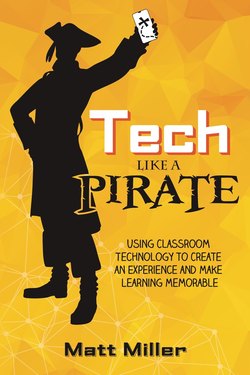Читать книгу Tech Like a PIRATE - Matt Miller - Страница 11
На сайте Литреса книга снята с продажи.
When Risk-Taking Is Worth It
ОглавлениеNear the top of my list of guilty pleasures is Top Gun, a classic film of the 1980s. I rarely pass up an opportunity to watch it. It chronicles the journey of Pete Mitchell, a US Navy fighter pilot with the call sign Maverick. Maverick’s superior skills earn him a seat in the navy’s advanced combat fighter school, known as Top Gun.
When Maverick arrives for his Top Gun training, the school’s instructors find that he’s no textbook-compliant student. Maverick is a risk-taker. His combat tactics are unconventional. For example, in a training flight, he battles against Jester, one of his instructors. Jester approaches Maverick’s plane from the rear, the optimal place to be in a dogfight between two planes. Maverick tries the traditional moves to shake Jester off his tail, but to no avail. Then, in the moment, Maverick imagines a move that would catch Jester completely off guard. In the middle of this high-speed pursuit, Maverick decides to pitch the nose of his plane straight up and slam on the brakes, causing Jester to pass by and put Maverick in the better tactical position.
Now Maverick has Jester right where he wants him. Jester is scrambling for his life. When his skills can’t save him, Jester does what only an instructor can do in a training flight. He dives below the “hard deck,” the minimum safe altitude, effectively taking the competition out of bounds and ending it before Maverick can defeat him.
Maverick, however, won’t have it. He follows Jester out of bounds, flying dangerously low into the California mountains, and takes his shot. Maverick celebrates his victory over Jester.
When Maverick and his partner Goose reach the ground, the instructors aren’t celebrating. They chew Maverick out for breaking protocol and putting lives in danger. Maverick leaves the office with regrets.
Among themselves, though, the instructors know they’ve witnessed greatness. Maverick has an improvisational, creative way of flying that they’ve never seen. He has a talent for looking at the risk-to-reward ratio and knowing when a risk is worth taking.
Here’s how Maverick decided whether a risk was worth taking. He sized up the situation. He weighed the possible options and each option’s outcomes. He decided whether the potential benefits were worth the risk. Then he acted.
When we think about the risk-to-benefit ratio in the classroom, it looks more like this:
We find something about our class that we’re not satisfied with.
We decide that we’re ready for a change.
We start to brainstorm better ways of doing things.
When we come to a solution, we worry about failing.
We educators tend to be a skittish sort when it comes to failure. (That’s interesting, because we encourage our students to try new things and risk failure every single day.) Risk scares us. It keeps us from pursuing our best ideas because, we tell ourselves, something might go wrong.
But what if those things that feel risky aren’t so risky at all? What if our fears had very little substance?
It’s time to reframe the term risk.
You know what doesn’t feel risky? The status quo. Education as expected. Talking at students. Marching chapter by chapter through a textbook. Assigning mindless worksheets. Teachers have taught this way for ages. It isn’t going to rock the boat or ruffle anyone’s feathers. If we teach this way, we can fly under the radar, avoid parent phone calls, receive satisfactory evaluations, and keep our jobs. So goes our inner script, even if we’re not always even aware of it.
Teaching to the status quo feels safe. But is it safe? What if it doesn’t get results? And what if we continue to teach using the same old techniques even though we know they’re not getting great results?
Seen in this light, the status quo is not safe, but risky.
The definition of risk is a situation involving exposure to danger. Teaching that feels safe, but where students are less likely to learn, is risky. It’s even, in its way, dangerous. Anything we do that doesn’t help students realize their potential is dangerous. Risky. A wasted opportunity.
Safe, comfortable teaching is simply risky teaching.
Let’s take it back to our Top Gun analogy. As a fighter pilot, Maverick could have relied on the “safe” combat tactics, the ones that other fighter pilots used. But against Jester, the same old tactics would have led to Maverick’s demise.
For Maverick, safe flying was risky flying. Jester was going to beat him.
For us, safe teaching is risky teaching. If playing it safe isn’t getting us results, we can’t keep doing what we know doesn’t work—even if change makes us comfortable.
